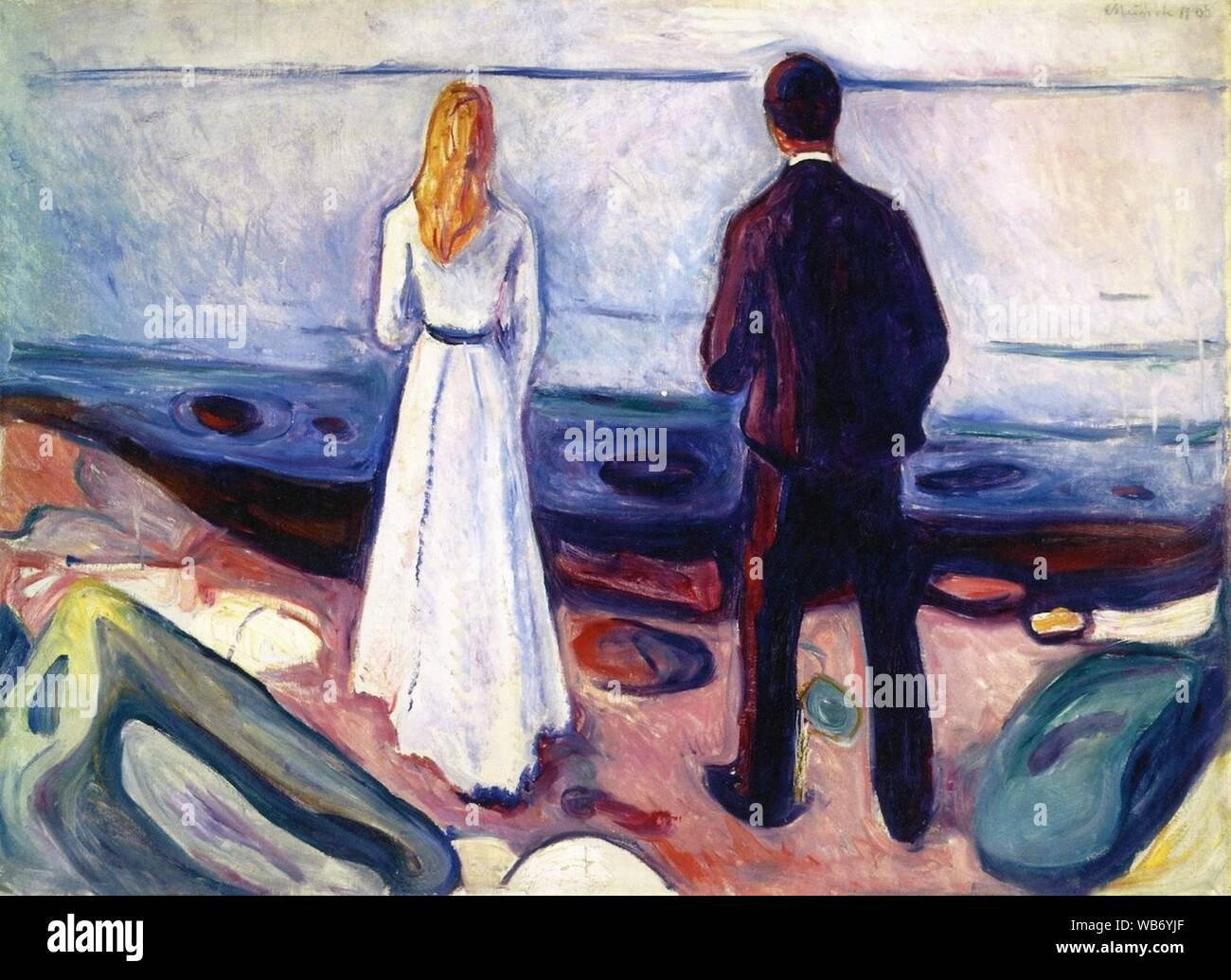Edvard Munch’s captivating piece, “Two Human Beings (The Lonely Ones),” painted between 1906 and 1908, is currently showcased at the Harvard Art Museums. This oil on canvas artwork portrays a man and a woman standing side by side on a rocky shore, facing away from the viewer, encapsulating a profound sense of isolation that resonates deeply with many art enthusiasts. Munch, a pivotal figure in modern art, knew no bounds in his exploration of this motif throughout his career, producing variations on the theme reflecting his innovative techniques. Through meticulous detail and occasional spontaneity, he skillfully captured the complexity of human emotion that reverberates through the ages. The ongoing art exhibitions featuring Munch’s works allow viewers to explore the nuances of connection and solitude in “Two Human Beings” and beyond.
The artwork known as “The Lonely Ones” exemplifies Edvard Munch’s intense exploration of human relationships through his iconic representations of companionship and isolation. Displayed at the Harvard Art Museums, this renowned piece has captivated audiences for decades, inviting contemplation of the intricate dynamics between two figures amidst the vastness of nature. By examining Munch’s unique artistic techniques and the recurring theme of humanity’s solitary experiences, one can gain valuable insights into the emotional landscapes that define his oeuvre. Visitors are encouraged to engage with these modern art masterpieces that reflect both the struggles and connections inherent in the human condition. With its striking visuals and layered meanings, Munch’s work continues to spark discussion and intrigue amidst the changing tides of contemporary art.
Exploring Edvard Munch’s ‘Two Human Beings’
Edvard Munch’s painting, ‘Two Human Beings (The Lonely Ones),’ encapsulates over four decades of the artist’s profound fascination with the emotional landscape of human connection and isolation. This work, prominently displayed at the Harvard Art Museums, showcases Munch’s unparalleled ability to weave complex narratives through the nuances of two figures standing side by side, yet seemingly worlds apart. Their posture, gazing solemnly towards the sea, evokes a deep sense of introspection, encouraging viewers to reflect on themes of loneliness and companionship. As a pivotal piece within Munch’s oeuvre, it represents a significant exploration into the depths of human emotion, making it a crucial subject of discussion in modern art circles.
The continuous exploration of this motif by Munch highlights his experimental approach to artistic technique. Throughout his career, he revisited this theme repeatedly, reinterpreting the figures with varying colors and styles. Each iteration not only captures the evolution of Munch’s artistic technique but also offers insight into the shifting perspectives on intimacy and isolation throughout his life. The fact that ‘Two Human Beings’ has been recreated in various formats—including prints and woodcuts—reveals how Munch’s engagement with the subject matter reflects broader questions about human relationships in the modern age.
Frequently Asked Questions
What is the significance of Edvard Munch’s painting ‘Two Human Beings’?
Edvard Munch’s ‘Two Human Beings (The Lonely Ones),’ created between 1906 and 1908, is significant as it reflects his exploration of human emotion and connection over a 40-year period. This motif, depicting a man and woman on the shore, symbolizes themes of isolation and companionship, showcasing Munch’s evolving techniques in painting and printmaking.
How many versions of ‘Two Human Beings’ did Edvard Munch create?
Edvard Munch created numerous versions of ‘Two Human Beings,’ with variations in technique, color, and form. His repeated focus on this motif illustrates his artistic journey and experimentation, resulting in a collection that includes paintings, prints, and woodcut versions developed over four decades.
Where can I see Edvard Munch’s ‘Two Human Beings’ exhibited?
You can see Edvard Munch’s ‘Two Human Beings’ exhibited at the Harvard Art Museums. The piece is part of the exhibition ‘Edvard Munch: Technically Speaking,’ which runs until July 27, featuring a significant collection of Munch’s works.
What themes does Edvard Munch explore in ‘Two Human Beings’?
In ‘Two Human Beings,’ Edvard Munch explores themes of loneliness, connection, and human emotion. The painting invites viewers to reflect on the complexities of relationships and the feeling of isolation that can exist even in the presence of another.
What techniques did Edvard Munch use in ‘Two Human Beings’?
Munch employed various techniques in ‘Two Human Beings,’ including dynamic brushwork, the use of color contrasts, and innovative printmaking methods. He often left parts of the canvas unpainted, enhancing the painting’s emotional impact and creating a sense of vibrancy and movement.
How does the Harvard Art Museums interpret Edvard Munch’s ‘Two Human Beings’?
The Harvard Art Museums interpret Edvard Munch’s ‘Two Human Beings’ as a multifaceted exploration of both solitude and connection. Curators emphasize that the recurring figures, situated in nature, suggest not only isolation but also a profound connection between the two figures and their environment.
What makes Edvard Munch’s ‘Two Human Beings’ a modern art masterpiece?
Edvard Munch’s ‘Two Human Beings’ is considered a modern art masterpiece due to its emotional depth, innovative techniques, and the articulation of complex human experiences. Munch’s ability to convey psychological themes through visual art marks him as a pivotal figure in modernism.
What influence did Edvard Munch’s personal experiences have on ‘Two Human Beings’?
Edvard Munch’s personal experiences influenced ‘Two Human Beings’ profoundly. His struggles with isolation, relationships, and mental health are reflected in the artwork’s themes, allowing audiences to connect emotionally and explore the artist’s psyche through his recurring motifs.
What role did color play in Edvard Munch’s ‘Two Human Beings’?
Color plays a crucial role in Edvard Munch’s ‘Two Human Beings,’ with various versions showcasing a wide spectrum from monochromatic schemes to vibrant, psychedelic hues. These color choices enhance the emotional resonance of the piece and reflect Munch’s continual experimentation with visual elements.
What can visitors learn from Edvard Munch’s ‘Two Human Beings’ at the exhibition?
Visitors to the Harvard Art Museums can learn about the evolution of Edvard Munch’s artistic techniques and philosophical explorations through his ‘Two Human Beings.’ The exhibition provides insights into Munch’s creative process and the themes of human connection and existential contemplation present in his work.
| Key Points |
|---|
| Edvard Munch’s painting, ‘Two Human Beings (The Lonely Ones),’ was created between 1906-1908 and is part of the Harvard Art Museums collection. |
| The painting features two figures, a man and a woman, who appear isolated despite being side by side, reflecting themes of loneliness and contemplation. |
| Munch produced numerous versions of this motif, employing different techniques and color schemes, showcasing a blend of painting and printmaking. |
| This motif has been interpreted in various ways, from loneliness to companionship, challenging traditional views of isolation. |
| Munch embraced imperfections in his artwork, rejecting the idea that a polished finish is necessary for quality. |
| The exhibition ‘Edvard Munch: Technically Speaking’ runs until July 27 and features many of Munch’s works, emphasizing his artistic exploration. |
Summary
Edvard Munch’s ‘Two Human Beings’ represents not only the artist’s deep engagement with themes of isolation and companionship but also showcases his innovative approach to art over four decades. This repetitive exploration reveals a complex interplay between the figures and their environment, inviting viewers to reconsider the nature of human connection. The ongoing exhibition at Harvard Art Museums highlights the significance of Munch’s work, encouraging a deeper understanding of his artistic legacy.



